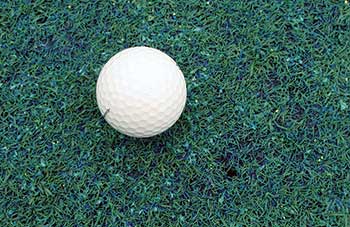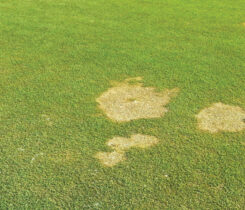A prolific seed producer anywhere

Poa annua seedheads on putting greens can affect surface smoothness and ball roll. Controlling them before they emerge reduces playability issues and helps the turf conserve energy. (Photo courtesy of Elliot Dowling)
Poa annua is a prolific seed producer at any height of cut. The ability to seed contributes to spread, and the seedheads can affect putting green smoothness in the spring. Poa plants are also noticeable on bermudagrass fairways that are starting to green up.
Managing seedheads is necessary in many cases, especially on putting greens. Suppression of seedheads is possible with properly timed growth regulator applications. However, once seedheads emerge, suppression is no longer possible.
You can remove seedheads mechanically with brushing, verticutting or grooming. However, it is essential to be careful with aggressively brushing or grooming grass that is not actively growing. If performed too often or too aggressively, mechanical methods can hurt the desired grass and slow spring development. Continue to mechanically remove seedheads this spring and plan for preventive programs this fall and winter.
Several herbicides are available for selective control of Poa annua and broadleaf weeds in bermudagrass tees and fairways. It is important to control the plants with postemergence herbicides so that seeds do not spread with mowing and increase the population, making control more difficult next year.
If you are not on a preventive program for Poa seedhead control, perhaps it is time to consider one. For putting greens, ongoing research suggests that preloading Poa with a late fall application of the growth regulator Proxy can help suppress seedheads. Timing varies, but the most recent research shows promising results with the following program:
- One application after the last mowing in the fall;
- An initial spring application between 200 and 500 growing degree days with a base of 32 degrees Fahrenheit; and
- A final application three to four weeks after the initial spring application.
On bermudagrass, applying a preemergence herbicide in late summer to early fall will control the emergence of Poa plants from seed in the soil. The turfgrass researchers at the University of Tennessee examined several products for preemergence control of Poa. If plants still germinate, waiting until the bermudagrass is dormant and applying a nonselective herbicide will clean the rest of the plants up.
For two excellent webinars on Poa annua, visit the links below:
2019 Poa Day, University of Tennessee, https://vimeo.com/332017868
2020 Resist Poa, USDA-ARA Annual Bluegrass Collective, http://resistpoa.org/webinars/












